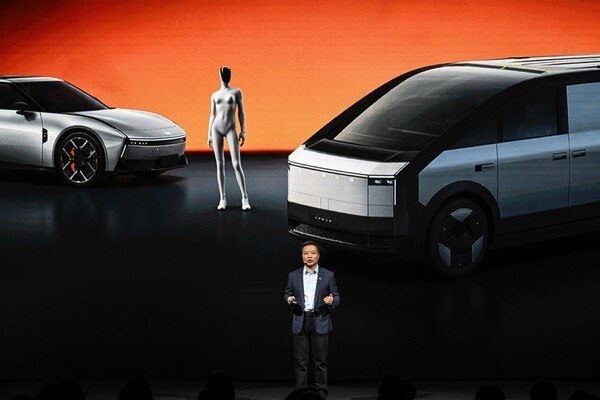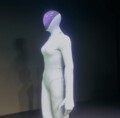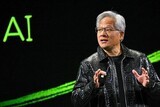Based on next-gen VLA model — unveiling new robotaxi, humanoid robot, and flying car
Chinese electric vehicle manufacturer Xpeng announced plans to launch three robotaxi models, a humanoid robot, and a flying car next year — all powered by its self-developed AI chip “Turing.” The company aims to outpace Tesla in the autonomous driving race.

Robotaxi lineup with in-house “Turing” AI chip
According to reports from the South China Morning Post (SCMP), CNBC, and Reuters on November 6, Xpeng co-founder and CEO He Xiaopeng revealed at the company’s “AI Day” event in Guangzhou that the upcoming lineup will feature the Turing AI chip and the second-generation physical AI model “VLA (Vision-Language-Action)” system.
Each robotaxi will be equipped with four Turing chips, delivering 3,000 trillion operations per second (TOPS) — enabling ultra-high-speed computation.
“Vision-based learning improves efficiency” — More refined autonomous driving
Xpeng explained that its second-generation VLA model enhances efficiency by relying on visual learning rather than language-based reasoning, thereby reducing information loss.
CEO He emphasized that Xpeng’s driverless taxis can operate even in narrow or complex road conditions and will integrate Alibaba’s Amap navigation and ride-hailing platform.
He also shared comparative test results between Xpeng’s latest VLA-based system and Tesla’s FSD (Full Self-Driving).
During a 54-minute test drive, Tesla required 7 driver interventions, while Xpeng completed a 49-minute drive with only one.
The robotaxi lineup will include 5-, 6-, and 7-seater models, each priced under 200,000 yuan (approximately 40 million KRW).
Humanoid robot “Iron 2nd Gen” with three AI chips
Xpeng also unveiled the second generation of its humanoid robot “Iron”, an upgrade to the 2023 model that competed with Tesla’s Optimus.
The new model integrates three Turing AI chips and will enter mass production of about 1,000 units per year starting next year.
He noted that due to China’s relatively low labor costs, factory applications are less economical, so the company will first target service roles such as tour guides and sales assistants.
He added, “I can’t predict exactly how many robots we’ll sell in the next 10 years, but it could be more than cars.”
Flying car mass production — 10,000 units planned, 500 km range target
Finally, Xpeng announced plans to produce 10,000 flying cars next year, entering full-scale mass production.
The upcoming successor to the A868 model will target a flight range exceeding 500 km, top speed of 360 km/h, and flight time over two hours.
Through these launches, Xpeng aims to establish an integrated “Physical AI ecosystem” encompassing autonomous vehicles, humanoid robots, and flying cars, all powered by its proprietary AI technology.
By Choi Song-ahㅣneria97@hanmail.net
- Jensen Huang: “In the AI race, China will be the ultimate winner”… Criticizes U.S. export ban
- AI Emerges as the “New Normal” in Cyberattacks... Google GTIG’s 2026 Security Outlook
- China’s Unitree Unveils 180cm Humanoid Robot “H2,” Shaking Up the Market
- “A Brand That Once Sold Less Than One Phone a Day in Korea”… Motorola Overtakes Samsung with Foldable Phones
- Samsung’s “Tri-Fold Phone” Core Technology Leaked to China...Global Strategy in Jeopardy
- Samsung to Unveil “Tri-Fold Phone” at APEC...A Bold Move in Next-Generation Form Factors
- China Unveils the World’s First Humanoid Robot That Learns New Skills in Just 10 Minutes
- The Era of Robot Parking: Kakao Mobility and Hyundai Wia Make It Real
- Flying Cars Take Off in China, But Korea Is Still “Waiting for Test Flights”
- DeepSeek’s ‘Genius Developer’ Luo Fuli Chooses Xiaomi After All
- Tesla Isn’t Just Building Cars...It’s Engineering an AI Empire Aimed at Earth and Beyond
- “XPENG Humanoid Walks So Naturally People Thought a Human Was Inside…” CEO Unzips Robot On Stage to Shut Down Rumors
- Figure AI Faces Lawsuit After Former Safety Chief Claims He Was Fired for Warning About Robot Risks

![[동학] 카카오톡 친구탭, 결국 12월 롤백… “격자형 피드는 선택 옵션으로”](https://cdn.kmjournal.net/news/thumbnail/custom/20251126/5517_10550_1119_1763853080_120.jpg)


![[테크 칼럼] 제미나이3, GPT-5.1을 넘다…AI는 이제 ‘일을 대신하는 시대’로 간다](https://cdn.kmjournal.net/news/thumbnail/custom/20251126/5457_10454_4847_1763621329_120.jpg)



![[낭만 테크 시대] AI 대항해 시대](https://cdn.kmjournal.net/news/thumbnail/custom/20251126/5603_10714_4334_1764121414_160.jpg)

